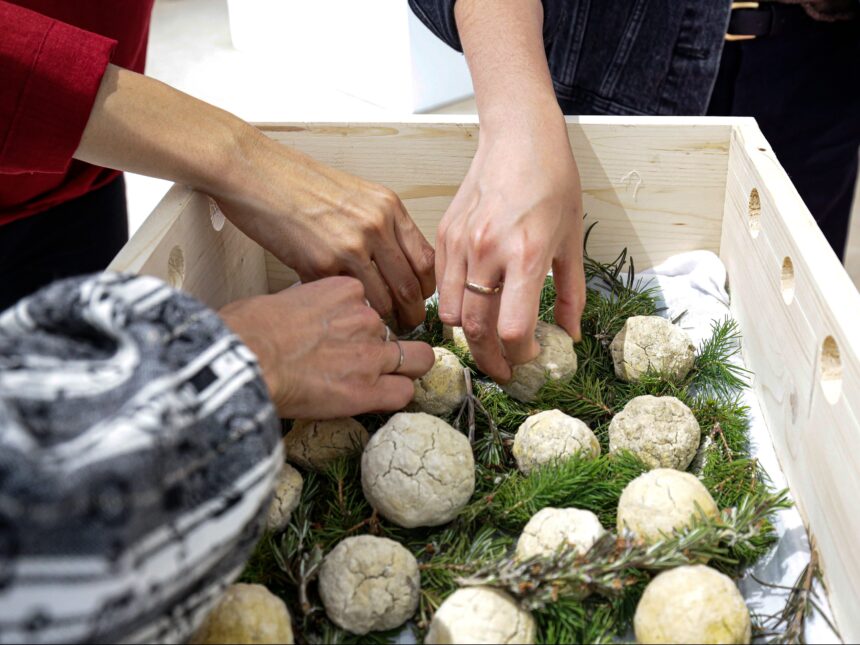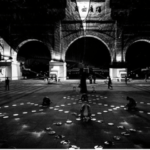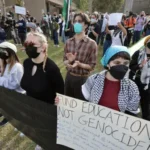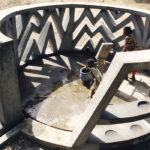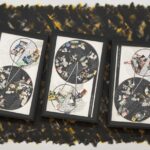Warm, Microbial Heaps: The Effervescent Practice of Rice Brewing Sisters Club
Joella Q. Kiu
In “Debated Territory: Toward A Critical Language for Public Art,” Suzanne Lacy’s seminal 1995 text about art that was made for and activated in the public realm, she provides the following description:
Alone in her studio, the artist creates through a struggle that, at various times, pits the individual against nature, culture, society, or the art world itself. [1]
This, according to Lacy, is the modernist mark of an artist. To further emphasize her point, Lacy includes a diagram. The diagram includes a single line that travels in a linear fashion along a horizontal plane. It is segmented into four points at equal parts along this line. Each point marks a different role that artists might embody – “experiencer”, “reporter”, “analyst”, and “activist”. Despite being set along a straight, continuous line, Lacy’s diagram insinuates movement along its trajectory. In Lacy’s opinion, an artist could assume expanded roles, ping-ponging between states. Whilst this text and its accompanying diagram were first published almost three decades ago, Lacy was dealing with what she termed “new genre public art”. Building upon Lacy’s ideas whilst tightening a loop around more recent developments, this essay will draw practices that have an ecologically conscious bent into focus. Philosopher Timothy Morton describes ecological awareness as the “awareness of unintended consequences” [2]. I hope to draw upon Morton’s assertion to think about practices that might sit comfortably with the ecological whilst embodying an outlook and output that might be characterized as nimble and serendipitous. On the other hand, within the space of the contemporary, there has been a real efflorescence around the possible functions of an artist. These roles, which will be another focus of my essay, have gone beyond the four capacities within which Lacy suggested artists could work, almost stretching to the point of thinness and disappearance.
This essay will expand on two recent projects by the artist collective Rice Brewing Sisters Club (RBSC). I will be reading RBSC’s practice in relation to key texts by scholars from the fields of communications and network studies. First published in 1964, engineer and computer scientist Paul Baran presented three different types of networks in diagrammatic form – centralized, decentralized, and distributed networks [3]. In a centralized network, the edges radiate out from a single point, thereby connecting all the subsequent nodes to one source. Decentralized networks are formed of several interlinked nuclei. Resembling a nervous system, each nucleus branches off into smaller functions. Finally, a distributed network might be best described as a tensile web. Though all the nodes within the network are linked to one another, there are no clear fulcrums or focal points. This means that resources, attention, and processing would be equitably administered in a distributed network system. Notably, there are fewer endpoints in distributed networks, as most nodes are related to one another. Baran wrote primarily in favor of moving away from centralized and decentralized networks towards a distributed future. To Baran, distribution was the only way to ensure the survival of a secure system.
Contemporary scholars, including Ulises Ali Mejias, have built on Baran’s ideas. In his book Off the Network: Disrupting the Digital World, Mejias asks us to think beyond the lines of a network, focusing instead on the bounded spaces between these lines:
To the extent that nodocentrism becomes the dominant model for organizing and assembling the social, only the paranodal can suggest alternatives that exist beyond the exclusivity of nodes. [4]
The paranodal, to Mejias, is how we move beyond the points of intersection towards an amorphous and aqueous patch of liminality. By dislocating our perception of the network, the paranodal also refutes the false binary that sets line and space on opposite ends to one another.
As we move from a consideration of linear diagrams to decentralized networks before finally arriving at the gaps in between, RBSC’s practice is undoubtedly informed by these various states of being. The artists often work within public or unconventional domains, and they demonstrate an interest in systems of distribution and translation. Instead of approaching the process of art making as a top-down, hierarchical affair that places the artist’s agency at the centre, RBSC destabilizes this by creating works that do not conform to this pecking order. These are works that are unbounded, community-focused, constantly evolving, and alive. In doing so, they also present a challenge to the anthropocentric worldview of art as being a material experience that is made for and by humans only. By pushing the role of the artist beyond being “individuals against nature, culture, society, or the art world”, they organize, mediate, carry, learn, build, cook, gather, and more.
Our works are less bound by mediums, and we see ourselves as constantly learning and being a novice whether it’s about drawing, painting, making prints, farming, cooking, writing, and, recently, surfing… [5]
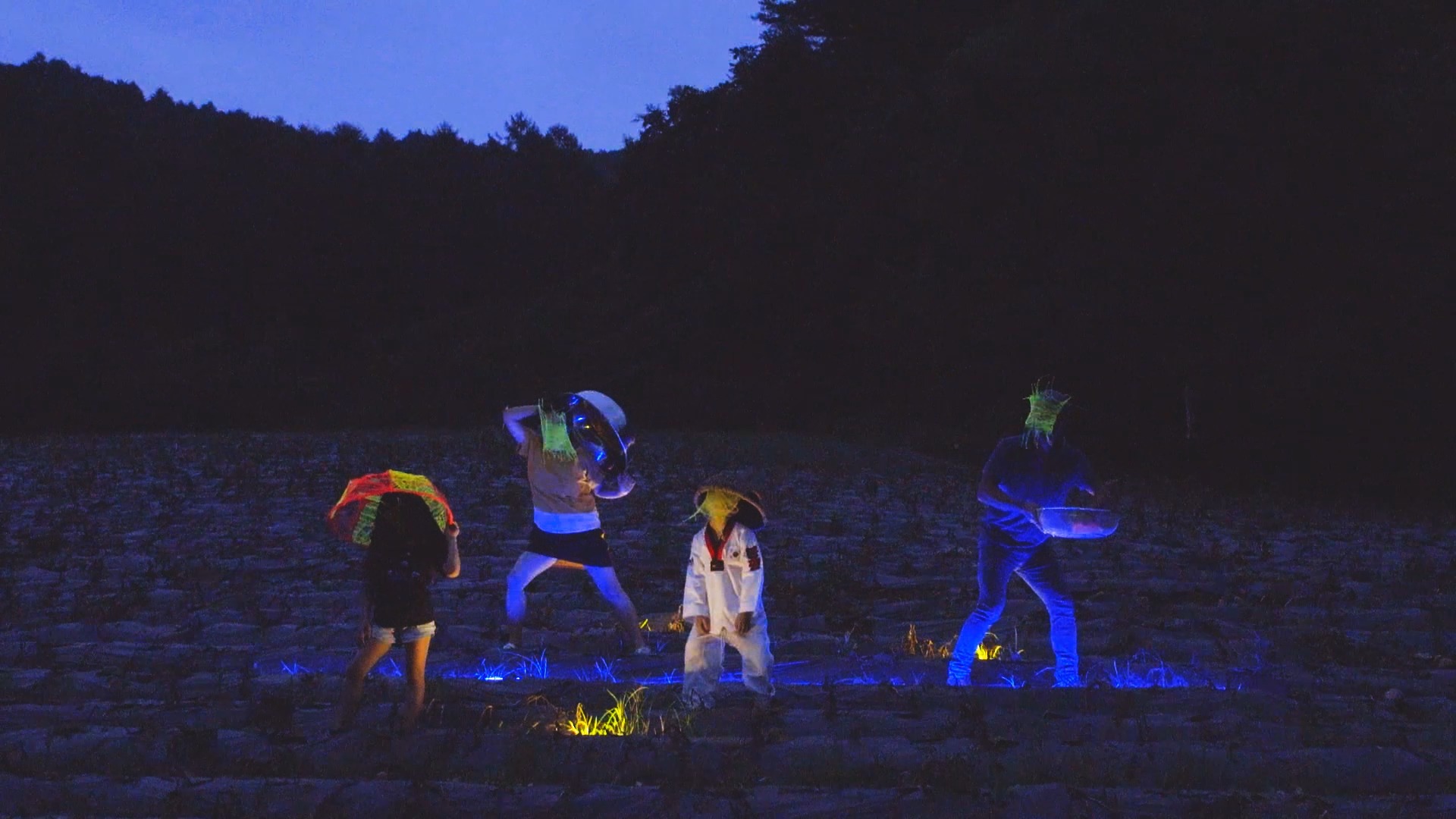
Rice Brewing Sisters Club is Hyemin Son, Aletheia Hyun-Jin Shin and Soyoon Ryu. They primarily operate out of South Korea. As their name suggests, RBSC started out with a keen interest in fermentation—particularly in the context of rice and its networks. Although the trio has produced a variety of installations and video work, a lot of their work is also immaterial or dematerial. This includes, but is not limited to, community work, sharing sessions, and workshops. Such rubberiness allows the collective to move between or amalgamate modalities seamlessly. Son, Shin, and Ryu describe this quality in terms of “elasticity” and apply this to their interests as well. Art making, to the collective, is “practice”. This means that it is an iterative process that involves experimentation, repetition, and failure both in terms of ideation and execution.
[We are] at a stage of thinking about whether certain attitudes, emotions, or the state of being in the same time and space together can be thought of as a form of aesthetics. [6]
Made two years ago in 2020, Mountain Storytellers, Storytelling Mountains: A Tale Theatre (첩첩담담 疊疊談談이야기극) is an earlier filmic work by RBSC. RBSC organized an exhibition in Bongpyeong-myeon, specifically a small village called Deokgeo-ri, and presented this work there. Bongpyeong-myeon is in the Gangwon Province of South Korea. It is characterized by mountainous and uneven terrain and is known for its scenic landscapes and buckwheat produce. Given the significance of agriculture to the village, ensuring that the harvest goes well has always been of utmost importance, and stories about guardian spirits such as the Gosari Goddess and Willow Tree Goddess are passed down from generation to generation. The residents “participated through storytelling, teaching [the artists] wild plant foraging, coming to [their] workshops, and actually performing in [their] film” [7]. All this community work resulted in a film that teeters between the oral tradition of storytelling and careful articulation of incantations.
RBSC’s approach to this work emphasizes the relational — a communion between human and more-than-human realms — through storytelling. The collective acknowledged that “the connection between mountains of Bongpyeong and mountain spirits was made quite seamlessly as it was already embedded in the agricultural production and economy of the village (the mountain spirits would determine the prosperity of the given year’s harvest, and the village had many shrines dedicated to each spirit)” [8]. In works such as Mountain Storytellers, Storytelling Mountains, the more-than-human is not an external world that exists beyond our vernacular realities, but one that is very much enmeshed within. The work takes viewers through a series of acts. Each act corresponds to a fable or story that was gathered through conversations with elders in the village of Deokgeo-ri, reanimating their narrative arc and characters. As mentioned before, the film features the residents of Deokgeo-ri across generations as performers. As stories about mountain clams and ginseng diggers are narrated, they are the figures we see moving through fields and streams. As the residents forage for leaves or make exchanges over sokuri (a round and shallow bamboo basket), they are completely fixated upon the task on hand, pulling the viewer into the scene and imbuing the vernacular with a meditative quality.

Furthermore, Mountain Storytellers, Storytelling Mountains is a film that does not prioritize the human gaze. Though the work often circulates within visual spaces, the work is not made solely for appreciation and consumption by humans. The film builds to a crescendo around the midway point as a motley crew of residents, each dressed in costumes composed of everyday objects such as baskets and metal bowls, draw into focus. Standing in a small field of crops, they hold various poses — some are bent over, and others stand upright. Elsewhere, the residents in the film dance around a tree whilst holding a bunch of fairy lights. In another scene, a single cane is reanimated by a thin piece of string. These scenes are fantastical and affective at once. By incorporating a touch of the spiritual through utterances and ritualistic movement, the work embodies the transcendental. It tends towards and functions as an offering to more-than-human ecologies whilst challenging its viewers to think about who this work is offered up to: human visitors, the non-human environment, or its spirit inhabitants? By refusing to privilege a human audience, the film undermines the central premise of the Anthropocentric epoch altogether. The work might also be read as being closely aligned with philosophies such as object-oriented ontology (OOO). Under the auspices of OOO, I am an object, this laptop that I’m typing on is an object, and the speck of dust in the air between my laptop and I is also an object. We are all objects, and most importantly, we are also all equal. The work manifests this egalitarianism by folding in the agency of its more-than-human partners. By expressing a desire to invoke spirits and goddesses, Mountain Storytellers, Storytelling Mountains becomes an open-ended refrain, a call that awaits a response.
Though it opens itself up to more-than-human realms, it remains legible to humans as a video installation. Against the backdrop of network theory as discussed earlier, it is important to note that the work largely circulates within the framework of conventional systems. This is despite the fact that the work itself resists a stratified approach in its making and is paranodal in its intent. However, in speaking to RSBC, it was clear that it was their desire to engage with a multi-generational community that compelled them towards working with film. This was pivotal as their desire was to design “a creative archive of oral stories of the elderly populations of the village but also that of younger residents’ poetic interpretation of those stories” [9]. RBSC was drawn to the fixative quality of film, and they saw film as a reliable time capsule, especially when compared to “more transient mediums, like performance of installation” [10]. These thoughts bring up an important point about how the medium of a work often determines its reception.
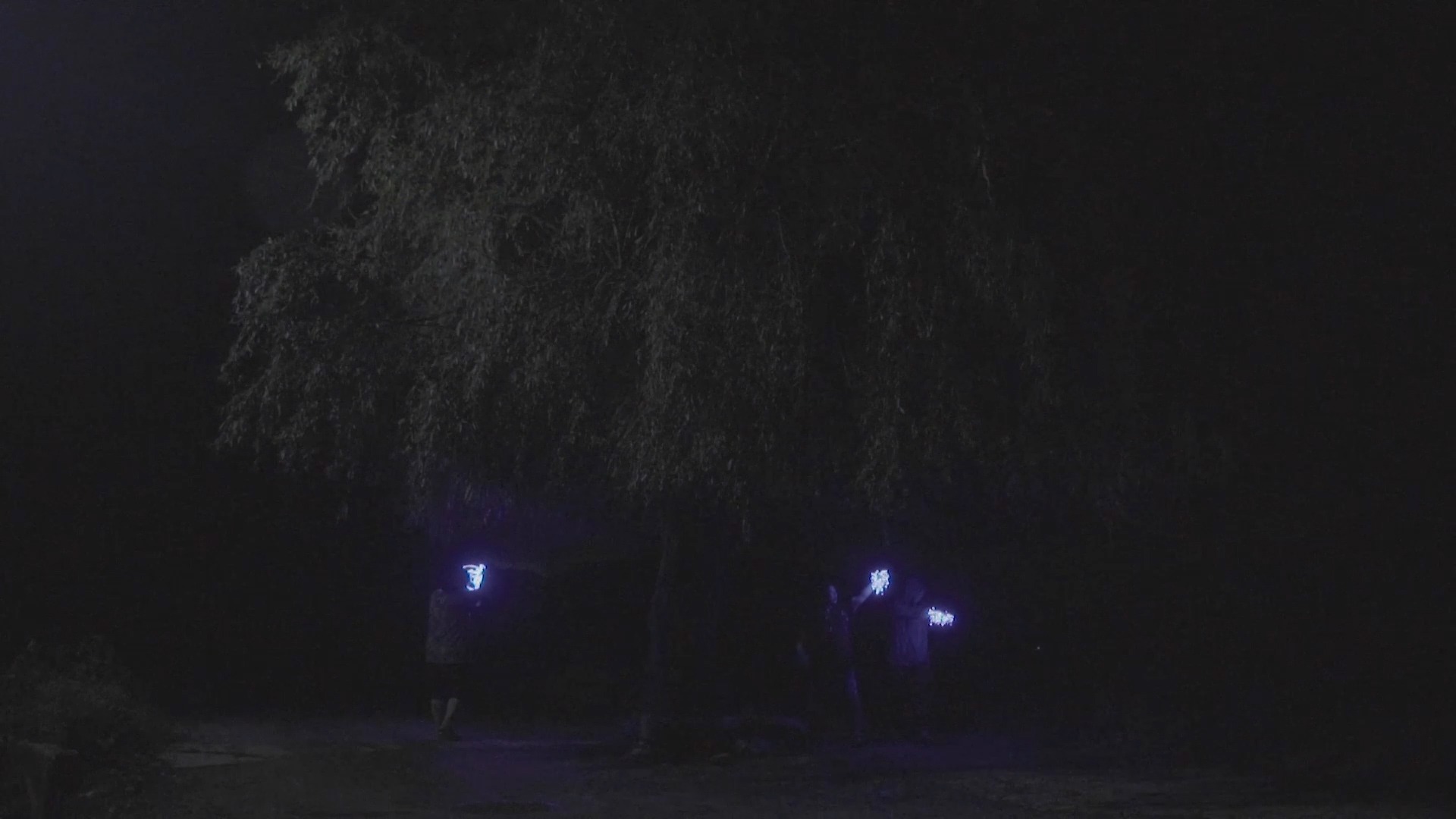
Since it was made, Mountain Storytellers, Storytelling Mountains has been shown at the Korean Cultural Centre (United Kingdom), NTU Centre for Contemporary Art (Singapore) and JWD Art Space (Thailand). It is one of the most, if not the most, well-circulated works by RBSC to date. Beyond the work’s compelling qualities, this might also be attributed to the flexibility and portability of the filmic format. The installation can be easily transferred, blown up or shrunk down, heard through speakers or headphones, projected onto a surface, or displayed on a monitor. In fact, it also gains additional affinities through its translation into languages such as English and Thai. All these possibilities demonstrate how a work such as Mountain Storytellers, Storytelling Mountains lends itself well to international or traveling presentations, accruing additional layers of meaning and forming far-reaching alliances through its extended circulation.
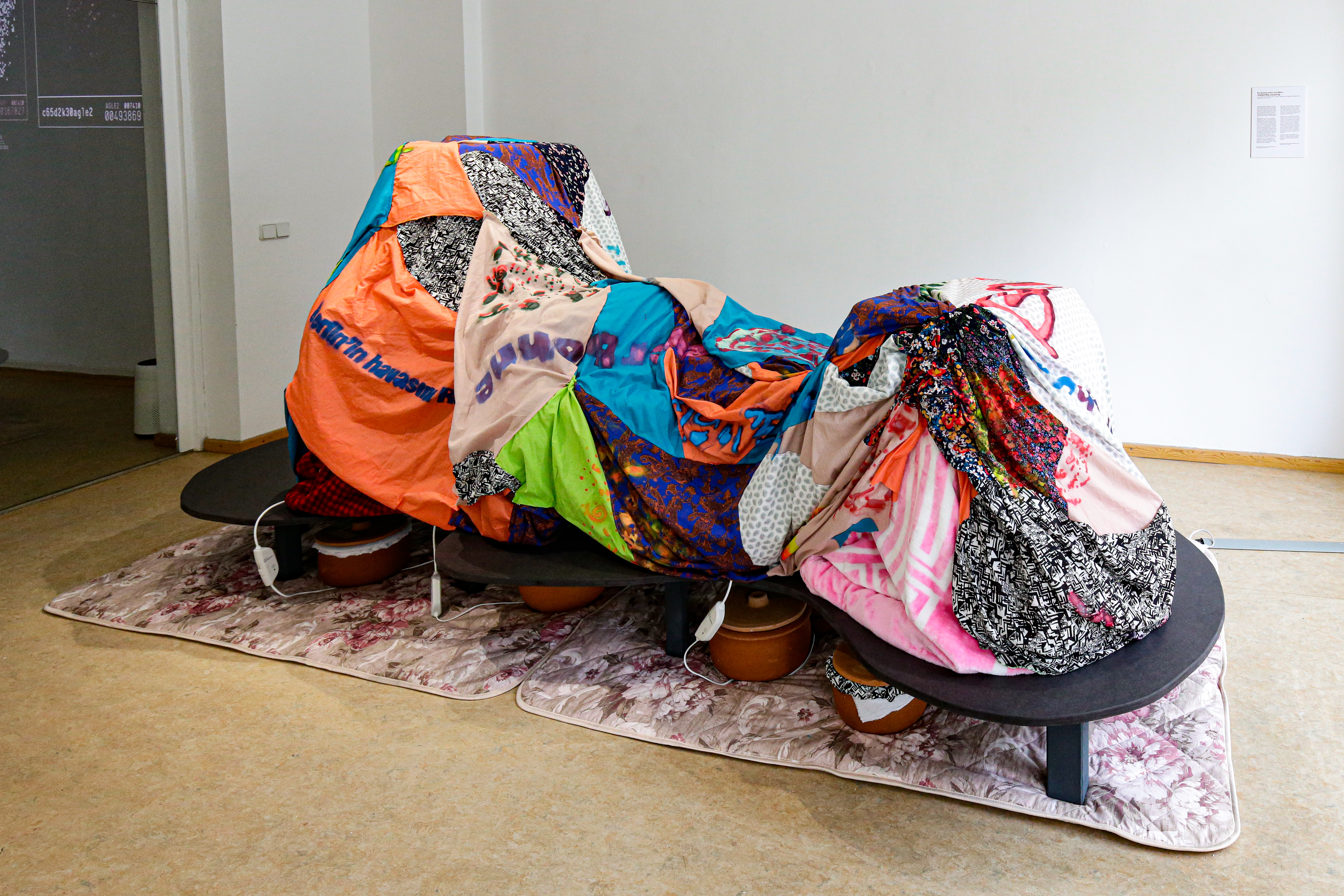
Much of our process of collaboration involves not only making but also living together – yes, literally living together sometimes, but also co-existing in the same time and/or space albeit as different organisms.[11]
My most recent encounter with RBSC’s work was in Berlin this year, at an exhibition titled Hackers, Makers, Thinkers: Collective Experiments in Social Fermenting. The show was held at Art Laboratory and featured a total of six artists. RBSC presented a new work here titled TERRESTRIAL-CELESTIAL, which might be best described as a warm, microbial heap. Electric blankets are draped upon one another, which in turn serve as the environmental shelter for a nesting structure for fermenting rice balls. Containing nuruk (a starter), the rice balls will eventually undergo seokkeottuiumbi (a composting method) to propagate and reintroduce indigenous micro-organisms into the soil they came from [12]. Ever mindful of engaging local communities in their practice, the work was made in collaboration with gardeners in Berlin who tend to Schrebergartens [13] in the urban city, who shared how they tend to their own gardens with the artists.
In drawing close to the installation, the first sensation I recall is that of warmth, as the heat emanating from the electric blankets grazed my skin. The scent of wood, dirt, and an almost nutty sweetness—filtered through the aroma of a slight roast—also hung in the air. Even without lifting the blankets to peer into the individual nesting boxes, the work had already begun to wrap around me. Given the unpredictable and durational nature of fermentation, TERRESTRIAL-CELESTIAL would be built along its own tempo, shapeshifting over the course of the exhibition. This means that the work I saw on a warm summer’s day in June would hardly be the same work when the exhibition concluded a month later in July. As with Mountain Storytellers, Storytelling Mountains, agency here is once again handed over to more-than-human operatives—in this case, microbes. Their involvement gives the work a life of its own. As the artists’ hands recede into the background, the microbes are hard at work, generating outcomes that might mutate beyond the limits of any simulation or projection.
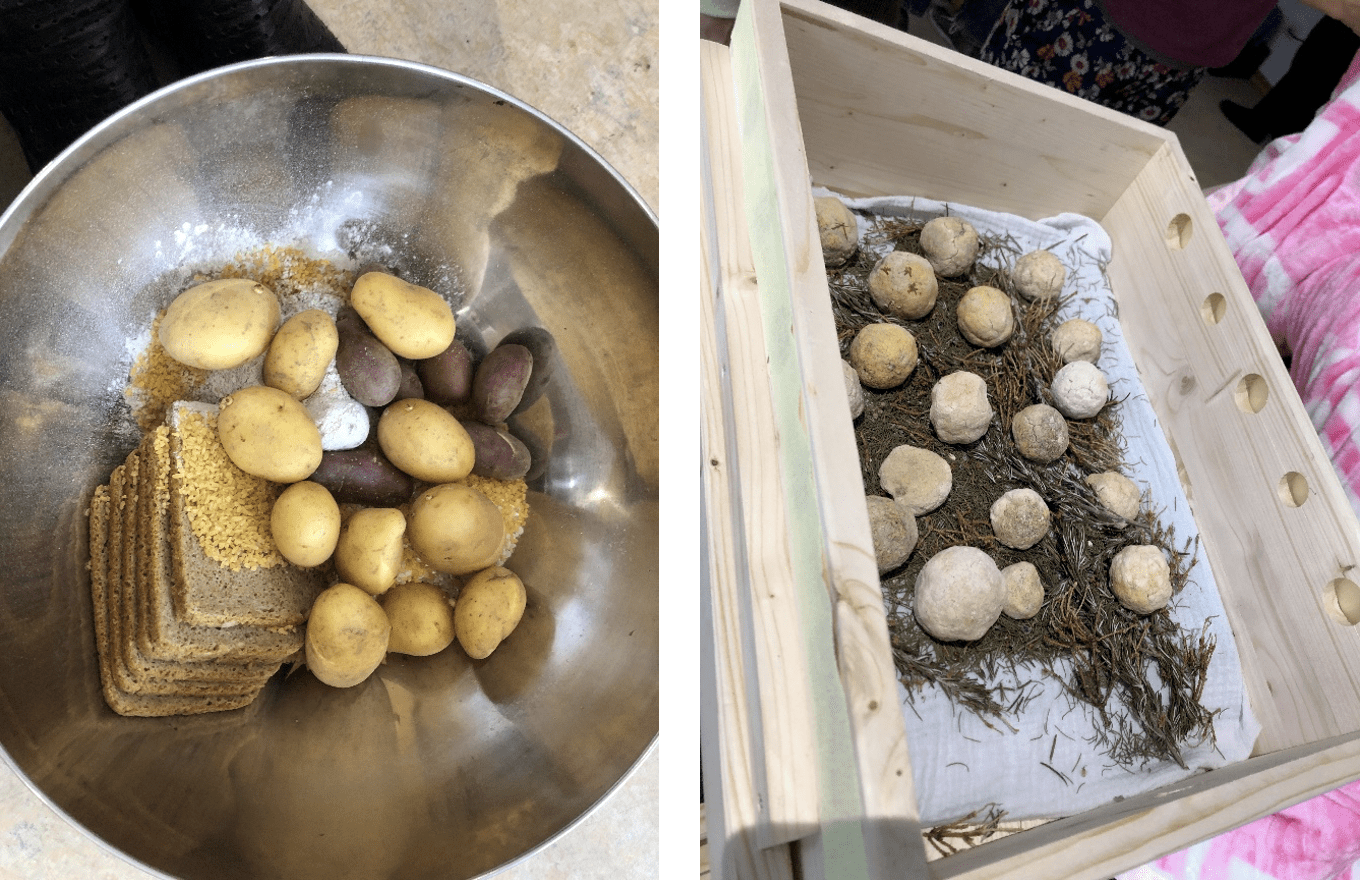
Whilst Mountain Storytellers, Storytelling Mountains does not privilege the human gaze, TERRESTRIAL-CELESTIAL takes this premise one step further. To facilitate the even fermentation of the rice balls, the structure must be kept mostly covered. Furthermore, though one can clearly see the fungi that cover the rice balls, the process of fermentation itself occurs on the scale of the microscopic, which is to say that it is largely indiscernible to the human eye. Whilst the artists were conscious that the installation designed by their collaborator and woodworker Jeonggil Ok would conceal much of the incubating rice balls from visitors, they still decided to move forward with it as they saw the “guesswork and attentive sensing that [are] required to read this work [as being] resonant with the process of fermentation—and perhaps by extension, with the task of understanding [different bodies of knowledge that are] very often grounded in somewhere else and practiced in unknown cultural backgrounds” [14]. In this context, the cloaked installation becomes a veiled knowledge and an aesthetic surface at the same time. The work challenges us to hold these seemingly contradictory states together when thinking about how we perceive—spinning a perennial philosophical question to a very different end: If a tree grows in a forest and no one is around to see it, do its new leaves exist at all? RBSC purports that not only do these new leaves exist—their existence does not need human validation.
While TERRESTRIAL-CELESTIAL engages with fermentation as an analogy or metaphor for epistemological transformation and absorption, the work also embraces fermentation as happening. In addition to the work metamorphosing throughout the exhibition’s duration, RBSC also made it a point to activate the work by way of workshops. The workshops placed great emphasis on the social experience of fermenting together. Workshop participants were asked to bring along carbohydrate-based food staples such as “rice, wheat, beans, potatoes or anything that microbes can sit and feed on” [15]. These ingredients were then used in fermentation. Participants were also invited to partake in the brewing of makgeolli (Korean rice wine). As the workshops were conceptualized as an integral part of TERRESTRIAL-CELESTIAL, they piled yet another layer of meaning onto the work by turning our attention to the convivial and somatic experience of fermentation. To RBSC, the importance of the workshops might be seen in their facilitation of decentralisation and communication. Moreover, not only did the artists and workshop participants make nuruk and seokkeottuiumbitogether, but the community farmers that RBSC collaborated with were also invited to share about how they tend to and care for their land. These farmers are immigrants, and their stories grounded the installation within larger contemporary events such as migration and urbanisation. This widens their collaborative network, dismantling the assumption that TERRESTRIAL-CELESTIAL was authored solely by RBSC and without external input.
Coming back to the installation component of TERRESTRIAL-CELESTIAL, the fermented seokkeottuiumbi will be “returned” to these community gardeners at the end of the fermentation process and exhibition, “so they can use it for further nourishing their land” [16]. The language RBSC uses to describe this reciprocity is important as it highlights how relational processes such as sharing, gifting, circulation, and reconciliation are foregrounded through these gestures. Though it can be read through the framework of art, the work and its various components transcend that condition by simultaneously being a system, structure, and dynamic. It is primarily immaterial, though it has material tendrils that reach outwards and beyond.
RBSC’s practice feeds into a renewed or reinvigorated interest in the interconnected web of life and our place or role within that. We know we’re not alone, or at the centre of the universe, or at the top of a food chain—yet it is not clear how we might move forward with that knowledge. Considering their approach to making works such as Mountain Storytellers, Storytelling Mountains and TERRESTRIAL-CELESTIAL, RBSC models one possible way for us through their practice—one that blows apart neat lines and trajectories with an interest in existing outside of the grid.
Building on these ideas, and circling back to earlier discussions around network theory, I’d like to propose that we think of these networks three-dimensionally – layered one above another, with lines overlapping and paranodes intersecting – in a manner that is not dissimilar to the vast, underground mycelial network. Mycelium is what nourishes, sustains, and makes tenable much of the natural ecosystem we see above ground. As the information and resource highway of the underground, fungal webs and mycelial networks pair up with tree roots to form mycorrhizal networks. Through these mycorrhizal networks, trees share with one another resources such as carbon, nutrients, and water. This creates an entangled web of relations that inextricably bind one organism to another, with each individual hyphae existing as one link in a much larger net. In many ways, fungi epitomize philosopher Donna J. Haraway’s call to “reimagine wealth, learn practical healing rather than wholeness, and stitch together improbable collaborations” [17]. Taken together, the image of mycelium and Haraway’s writing provide a stickier and messier yet more bountiful rendition of how an ecosystem might function.
Given this sculptural constellation, to locate the function of the artist might now present itself as a herculean task. Yet, RBSC’s works demonstrate that these complications are necessary and even accurate representations of the work of contemporary artists, particularly in the context of practitioners who align themselves with ecologically conscious practices. This model also allows us to think in terms of different scales, as artists who work ecologically might ply the routes between the microbial, the cellular, the bodily, the environmental, the planetary, and even the cosmic.
In Herbert’s seminal novel Dune, the imperial planetologist Pardot Kynes narrated his unique approach towards working on and with the desert planet:
The thing the ecologically illiterate don’t realize about an ecosystem is that it’s a system. A system! A system maintains a certain fluid stability that can be destroyed by a misstep in just one niche. [18]
As conversations around ecologically conscious art and art practices are often centered around flora, fauna and fungi, this paper interrogated how artists such as RBSC make sense of the “system” in “ecosystem”. Instead of co-opting their community and more-than-human actors into an anthropocentric fold, RBSC draws upon visceral processes such as digestion and fermentation to illustrate that how art is made and circulates and what art responds to need not be locked within unchangeable, unyielding diagrams. In doing so, they create, resist, and unpick systems of transmission, hegemony, and movement. Beyond engaging with place and environment, RBSC demonstrates an “awareness of unintended consequences” [19] by relinquishing full autonomy over their work and resting comfortably in their simultaneously unresolved, entangled, and ever-expanding nature.
Joella Kiu is a curator, editor, and art historian whose research extends into the transmission, reception, and localization of ecological frameworks within Southeast Asian contemporary art practices. Joella is currently Assistant Curator at the Singapore Art Museum, and Editor of the art historical online platform Object Lessons Space. Recent curatorial projects include Lonely Vectors (2022, Singapore Art Museum), REFUSE (2022, Singapore Art Museum) and to gather: The Architecture of Relationships (2021, Singapore Pavilion at the 17th International Architecture Exhibition of La Biennale di Venezia). Joella holds an MA in History of Art from the Courtauld Institute of Art (2017), and a BA in History of Art from the University of York (2015).
Notes
[1] Suzanne Lacy, “Debated Territory: Toward A Critical Language for Public Art,” in Mapping the Terrain, ed. Suzanne Lacy (Seattle: Bay Press, 1995), 171–188.
[2] Timothy Morton, All Art Is Ecological (London: Penguin Books, 2018), 16.
[3] Paul Baran, On Distributed Communications: I. Introduction to Distributed Communications Networks(Santa Monica: RAND Corporation, 1964), 2. https://www.rand.org/pubs/research_memoranda/RM3420.html.
[4] Ulises Ali Mejias, Off the Network: Disrupting the Digital World (Minnesota: University of Minnesota Press, 2013), 153.
[5] Rice Sisters Brewing Club, in discussion with the author, March 23, 2022.
[6] Ibid.
[7] Rice Sisters Brewing Club, in discussion with the author, August 1, 2022.
[8] Rice Sisters Brewing Club, in discussion with the author, March 23, 2022.
[9] Rice Sisters Brewing Club, in discussion with the author, August 1, 2022.
[10] Ibid.
[11] Rice Sisters Brewing Club, in discussion with the author, March 23, 2022.
[12] Indigenous microorganisms are microbes that exist as an innate part of the soil. Often abbreviated to IMO, they often aid in the process of composting and are known to play a key role in the regulation of plant ecosystems.
[13] A Schrebergarten is a small plot of land that can be found in urban cities around Germany. They are often cared for by the local community and used for urban gardening. For a more in-depth history of the development of these urban gardens: https://www.cabinetmagazine.org/issues/6/turowski.php.
[14] Rice Sisters Brewing Club, in discussion with the author, August 1, 2022.
[15] “HACKERS, MAKERS, THINKERS Seokkeodungdung: Doing “Social Fermentation”,” Art Laboratory Berlin, accessed July 14, 2022, https://artlaboratory-berlin.org/events/hackers-makers-thinkers-rbsc-workshop/.
[16] Rice Sisters Brewing Club, in discussion with the author, August 1, 2022.
[17] Donna J. Haraway, Staying with the Trouble: Making Kin in the Chthulucene (Durham and London: Duke University Press, 2016), 136.
[18] Frank Herbert, Dune (New York: ACE, 2010): 806.
[19] Morton, All Art Is Ecological, 16.

